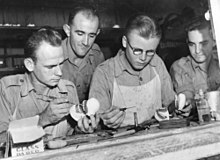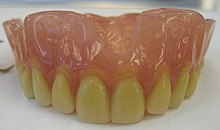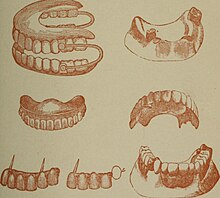|
Denturist
   A denturist in the United States and Canada, clinical dental technologist in the United Kingdom and Ireland, dental prosthetist in Australia, or a clinical dental technician in New Zealand is a member of the oral health care team and role as primary oral health care provider who provides an oral health examination, planning treatment, takes impressions of the surrounding oral tissues, constructs and delivers removable oral prosthesis treatment (including dentures and partial dentures) directly to the patient.[1][2][3][4] DefinitionsDenturism is defined as the practice by denturists of examining oral health, planning treatment, making artificial dentures including other removable oral appliances and fitting them to patients.[1][2][3][4] It is a recognized profession throughout the world and currently utilized in many countries including Australia, New Zealand, United States, United Kingdom and Canada. In the United States, denturism is only legislated and practiced in 7 states (Maine, Arizona, Idaho, Montana, Washington, Oregon, and Colorado).[1] However, in Australia, the United Kingdom and Canada, all states, provinces and territories recognize the profession.[2][3][4] The criteria and training to become a denturist vary by country and region, however after completion of required prerequisites which are completion of dental technology program or years experience in denturitry with completion of core required courses, generally the denturism programs take 3–5 years and the qualification ranges from a Diploma to a master's degree.[5][6] Due to the diversity in training, the scope of practice for a denturist can alternate between countries, however the general principle remains the same. Denturist curriculum contains courses such as, General biology, Micro biology, Human anatomy, Head and Neck anatomy, Dental anatomy, Physiolosy, Dental Materials, Dental technology theory, Infection prevention and control, Radiographic interpretation, Periodontology, Histology, Embryology, Nutrition, Psychology, Pathophysiology, Oral pathology, Pharmacology, Gerontology, Ethics, Removable and Fixed prosthetics, Implantology, Removable oral appliances, Clinical & Laboratory theory, Practice management, etc.[7] The program is competitive and selective. Prospective students are encouraged to complete and earn Dental Technology Degree prior to applying Denture Specialist Program. By acquiring Dental Technology knowledge prior to entering Denture Specialist Program would help students to follow course works with better understanding. Work experience from denturist clinic, denture laboratory and other dental field is plus to be succeed before and after graduation.[8] Role in the dental teamDenturists are an important part of the dental team. They often work alongside general dentists, dental specialists and other members of a dental team in both private and public sectors of the oral health workforce.[9] They can also work independently in their own clinic with patients providing appropriate management and treatment of dentures and other oral appliances. Denturists are well educated in clinical and technical knowledge of denture care, as well as completing many hours of practical skills in producing dentures. They ultimately receive more comprehensive study in oral prosthetics than any other health professional including the general dentist [10] since dental schools less emphasis in their curriculum about removable prosthetics and focus on implantology in contrast denturist schools teaches mainstream of removable prosthetics and dentures and spend several years for training.[9] Therefore, the collaborative role of denturists provides an important model of re-allocating dental services to alleviate stresses from the general dentists, reserving time for restorative, cosmetic, hygiene, and emergency dental procedures.[11] Denturists differ from both dental technicians and prosthodontists.[12] Dental technicians are registered members of the dental team who support dental practitioners in the delivery of dental services.[13] Prosthodontists are qualified dentists, who have specialized in making fixed or removable appliances for patients.[14] History of denturismDentures throughout the agesThe use of "false teeth" has prevailed throughout the course of history. Archaeological evidence dating back to 1500 B.C. was found in Egypt.[15] The Egyptians would use real teeth threaded with a gold wire to create a false set of teeth. In northern Italy 700 B.C., the Etruscans made dentures out of animal teeth.[16] Hence the world of dental prosthodontics began to take shape. Despite being made of low quality material and having short life spans, dentures were relatively popular. The first complete set of dentures is attributed to 16th century Japan.[17] They were known as the Japanese box and are quite similar in shape to modern day dentures.  In the 1700s, ivory dentures were developed from walrus, elephant or hippopotamus tusks.[18] Alexis Duchateu crafted the first porcelain dentures in 1770.[4] These were prone to cracking and appeared too white to be natural teeth. Duchateus was a pharmacist, since Denturist, as an occupation was yet to be established.[18] In the 1800s, the incidence of dental decay and tooth loss began to increase rapidly.[19] The industrialisation period meant the consumption of sugar among British citizens increased by 500 percent.[19] A need for an alternative form of dentures was needed. In 1815, the Battle of Waterloo gave rise to the highly demanded "Waterloo teeth".[20] These were dentures crafted primarily from the teeth of dead soldiers seated in a base of animal ivory. Waterloo dentures gave the appearance of natural teeth and were not as prone to breakage as porcelain dentures.[20] In 1820, Claudius Ash was given the task of crafting a new and improved form of dentures.[21] Ash was a silversmith and goldsmith.[4] He constructed porcelain on 18-karat gold plates.[21] The springs that held the dentures together were also made of gold. Dentures that were previously made from natural teeth or porcelain were both aesthetically and functionally inferior in comparison to Ash's design.[21] In the 1850s, Ash and his company developed Vulcanite (hardened rubber that seated porcelain teeth).[21] His company was the leading supplier of this form of dentures in Europe. Charles Goodyear was awarded the patent for Vulcanite-based dentures in 1851.[22] Dentures, at the time, were primarily focused on aesthetics. Early in the 20th century, Dentistry shifted from treatment based therapy to prevention and as such, dentures that were in line with good health became more favourable.[23] Having a clear occupation for dentures alone became a requirement.[23] Legal recognition of denturistsThe 1919 Tasmanian Dental Act made a clear distinction between the role of a Dentist and the practice of denture making.[23] For a patient that required dentures, a consultation by referral from a Dentist became normal procedure.[23] Denturism – that is the field of dentures - was not recognised until more recent times.[23]  The Health Amendment Act (1933) was the first legal document that gave rise to the practice of Denturism in Canada.[24] The Dental Mechanics Act of Alberta (1961) was the future update to this legislation allowing Denturists to begin work in the field.[25] They were also known as "Dental Mechanics" or "Denture Therapists."[25] This gave rise for the need for legal recognition of denturists in other countries.[25] In the United States, the first legally recognised Denturists were found in Oregon, 1971.[26] In 1974, denturists were first legally recognised and in 1978, Denture Therapists began practicing.[26] The increasing rate of ill-fitting, misaligned, unstable and unsupportive dentures motivated three Denturists in 1956 to pursue international recognition.[27] Rolf Pfenniger, Hannes Stiebler and Stephan Grabert formed the Internationale Arbeitsgemeinschaft der Zahnprothetiker. In English, this is the International Federation of Denturists.[27] Denturists have campaigned for the right to practice independently in many states, with the argument that they can provide greater access and lower-cost prosthetic services.[28] This argument has been disproved by examining other jurisdictions in the world which have both dentists and denturists. In Canada, six years after regulating of denturists commenced, the fees quoted in their fee guide were similar to those of dentists. Consequently, most of these campaigns have so far failed. In some jurisdictions, denturists must operate under the supervision or oral health certificate of a dentist. Many dentists argue that this does not happen. For example, in 1991, investigators hired by the Arizona Dental Association found that only three out of the state's 13 denturists advised callers to see a dentist before visiting them.[29] Many denturists argue that from a business point of view dentists are viewed as competition and in many locations dentists may "steal their business" after doing an exam.[30] With the work of the IFD and other denturist campaigns across the globe, there is hope for clearer recognition and scope in future. Training in different countriesAustraliaThe following programs of study have currently been approved by the Dental Board of Australia for the profession of dental prosthetics. On successful completion of the selected courses, individuals are required to register with the Australian Health Practitioner Regulation Agency to practice legally as a dental prosthetist.[31]
CanadaThe following programs of study have currently been approved by the Denturist Association of Canada for the profession of denturism. On successful completion of the selected courses, individuals are then required to complete a Qualifying Examination administered by the College of Denturists, consisting of two components: a written examination and a structured clinical examination. Upon successful completion of the examination, individuals may then register with the College of Denturists of Ontario to practice legally as a denturist.[32]
United StatesIn the United States, there are certain prerequisites that need to be completed before individuals can apply at either of the two programs of study approved by the National Denturist Association USA. The prequisites vary from prior work experience to related education in the dental field.
United KingdomThe following programs of study have currently been approved by the General Dental Council for the profession of clinical dental technologist. Required prerequisites must be completed prior to enter Clinical Dental Technology Program. On successful completion of the selected courses, individuals are required to register with the General Dental Council to practice legally as a clinical dental technologist.[34]
Scope of practice in different countriesThe scope of practice differs in each country, based on the training undertaken.      AustraliaThe following scope of practice has been outlined by the Australian Dental Association for registered dental prosthetists.[35]
United StatesThe following scope of practice has been outlined by the National Denturist Association for registered denturists.
United KingdomThe following scope of practice has been outlined by the General Dental council for registered clinical dental technologist.[36]
Additional skills which CDTs in the UK could develop include:
CanadaThe following scope of practice has been outlined by the Denturist Association of Canada for registered denturists.[3]
See also
References
|
Portal di Ensiklopedia Dunia
